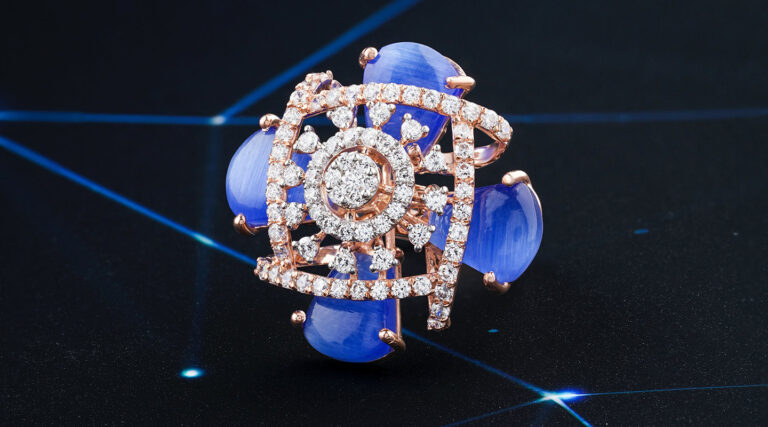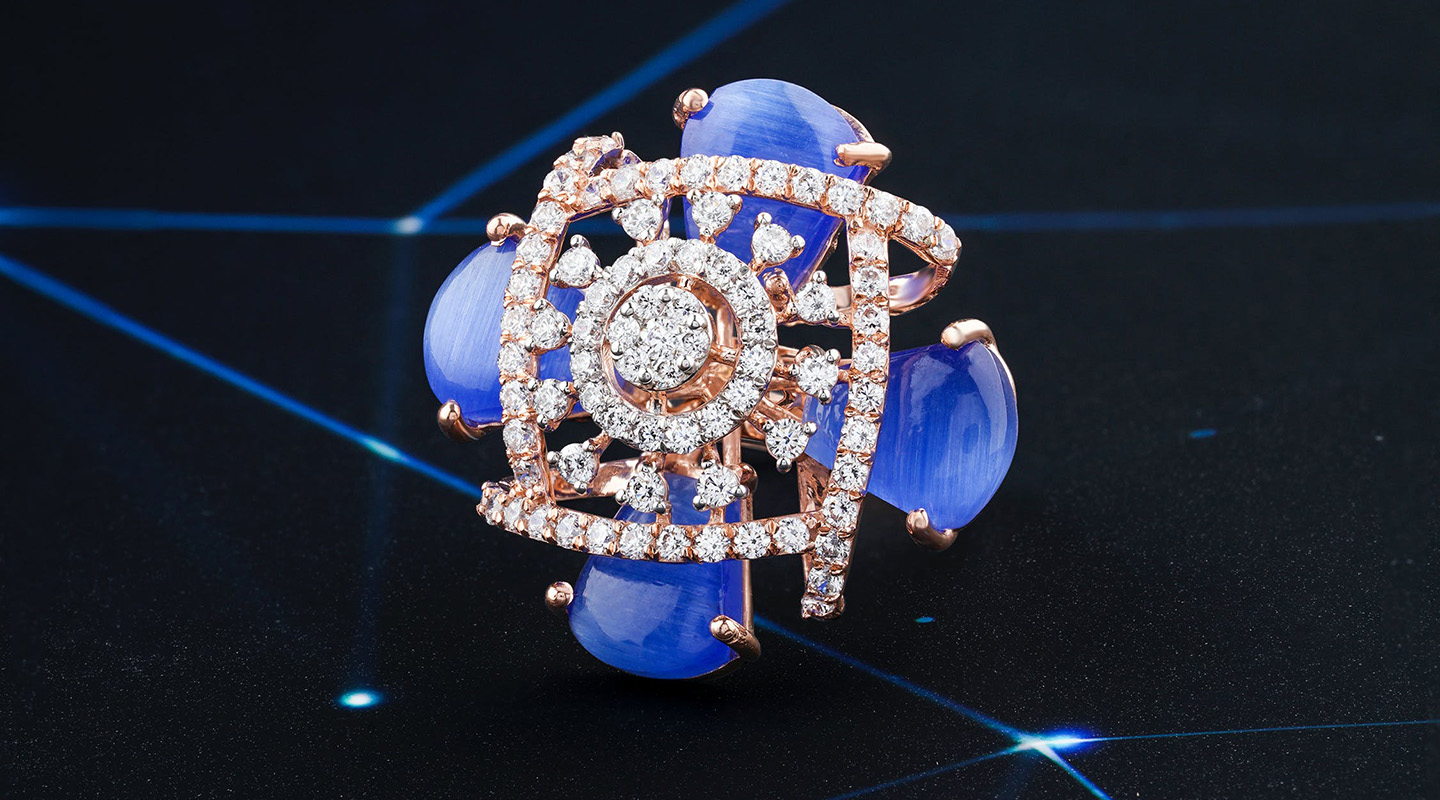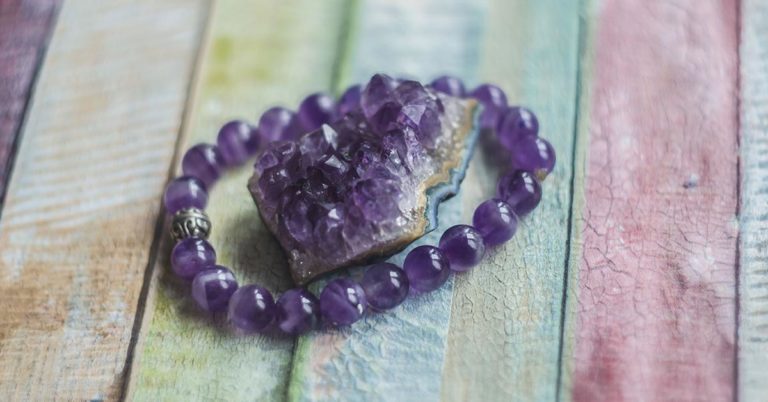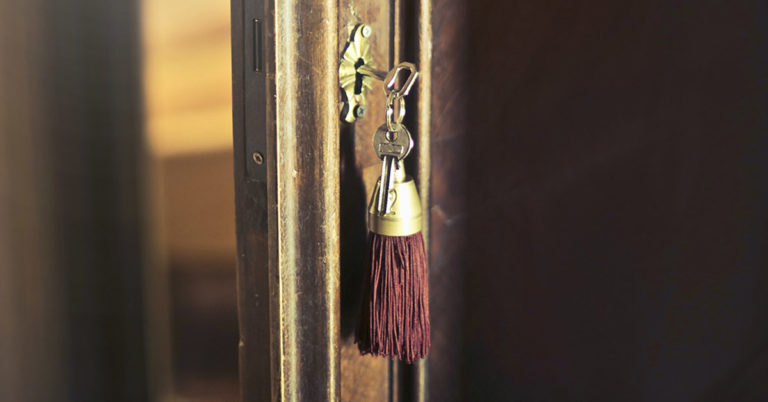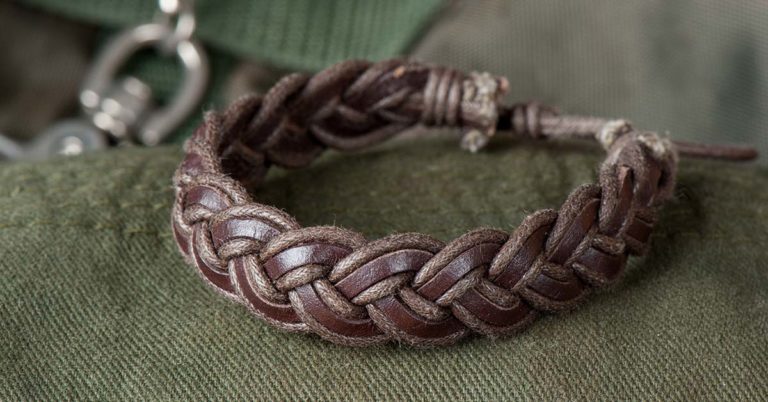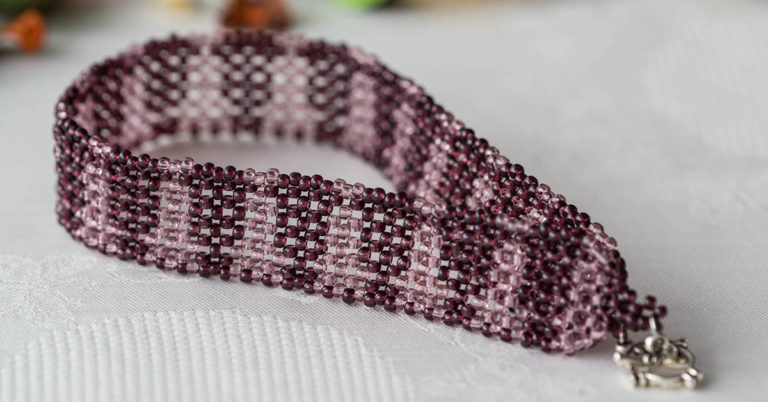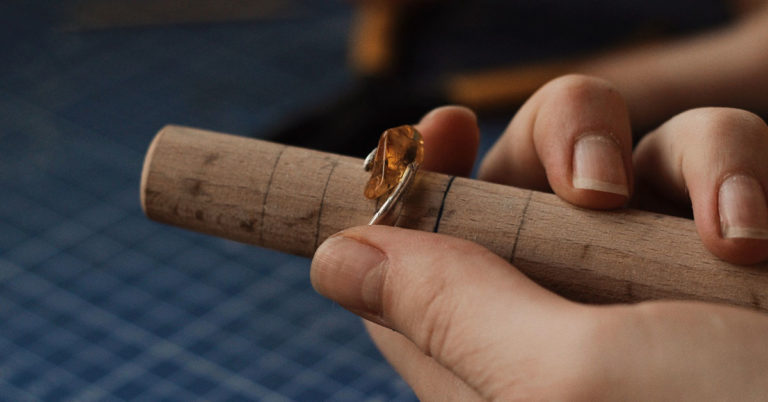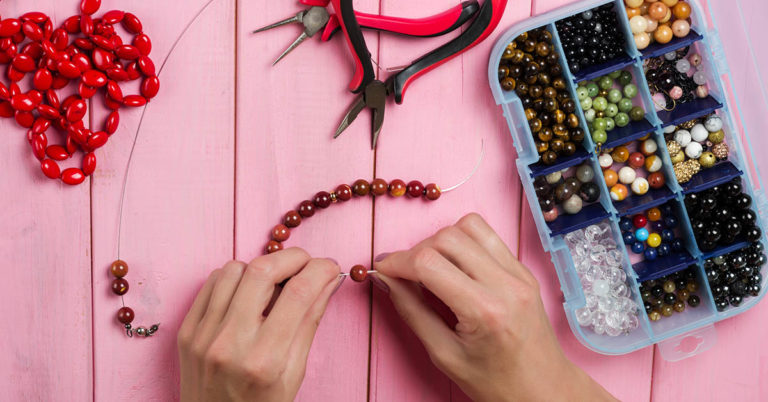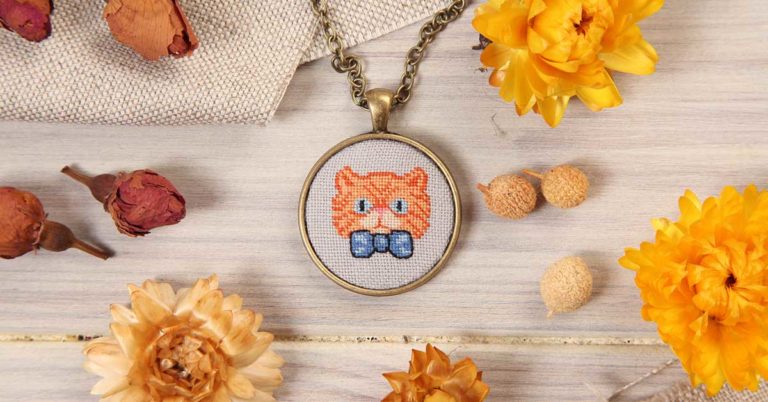What is estate jewelry?
In essence, estate jewelry is any piece that is second-hand: the key determining factor is that the item has had a previous owner. While many estate pieces are decades or even hundreds of years old, the term does not specify any particular age or historical period.
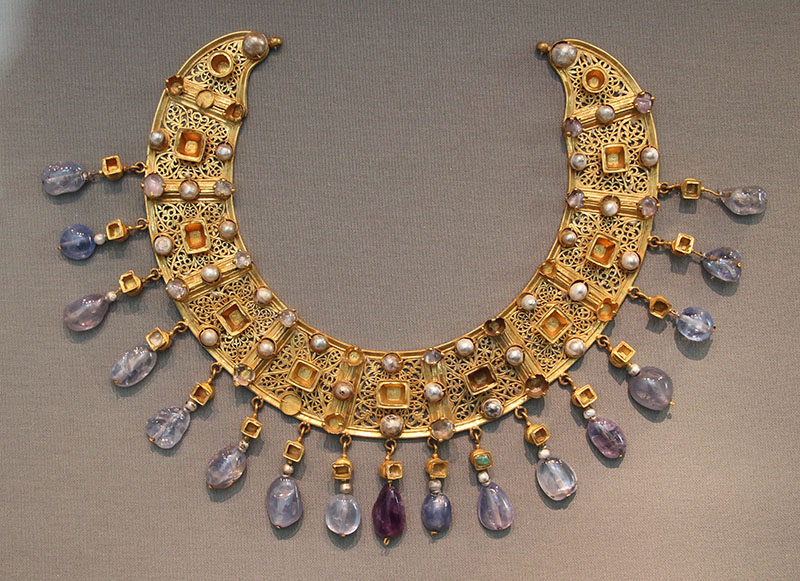
Source: Wikimedia / dbking
Technically speaking, a second-hand piece of jewelry that’s only a month or two old would be considered estate jewelry. However, most jewelers won’t classify a piece as estate unless it’s at least 30, or even 50 years old.
Although the term originally came from estate sales of deceased persons’ effects, the previous owner may or may not still be alive. It may be a piece that has been passed down by generations, sold following the death of someone, or simply an item that was previously owned by someone else.
Estate vs. Antique vs. Vintage – what’s the difference?
Jewelry can be an expensive purchase, but it can also be a wise investment as long as you know what to look for. Knowing the terminology around this type of item, especially the differences between estate, antique, and vintage jewelry, can help you to make a smart purchase and potentially save you a lot of money.
Although people sometimes use these terms interchangeably, they are actually quite different:
- Antique jewelry usually refers to a piece at least a century old. Because of its age, antique jewelry is typically made from valuable materials using expert craftsmanship. Often, pieces are highly valuable, so they’re more frequently seen as collectibles than wearable pieces.
- Vintage jewelry is younger than its antique counterparts: most experts consider any piece between 50 and 100 years old to be vintage. Their younger age generally makes them more affordable and less fragile than antique pieces, so people are more likely to actually wear them.
- Estate jewelry refers to any piece of jewelry with a previous owner. While estate jewelry is often antique or vintage, it is not necessarily from any particular era and may not be more than a few years old.
Of course, classifications of certain periods of jewelry as antique and vintage change over time. For example, Edwardian and Art Nouveau were previously seen as vintage eras, but as more than a century has now passed, they are officially classified as antique.
Although any given piece could be considered both estate and antique, or vintage and estate, there are certain norms when it comes to naming pieces. For example, a 150-year-old brooch would usually be called an antique brooch, even though it is also estate.
Classic jewelry periods
Whenever you buy a piece of estate jewelry, it’s essential to know what period it comes from, as this relates closely to how much the piece may be worth and the value of the investment.
Like fashion, art, and architecture, jewelry can be classified into specific, definable periods. Each of these periods is characterized by certain trends in style and aesthetics, as well as particular techniques and materials that were popular at the time.
Early antique jewelry
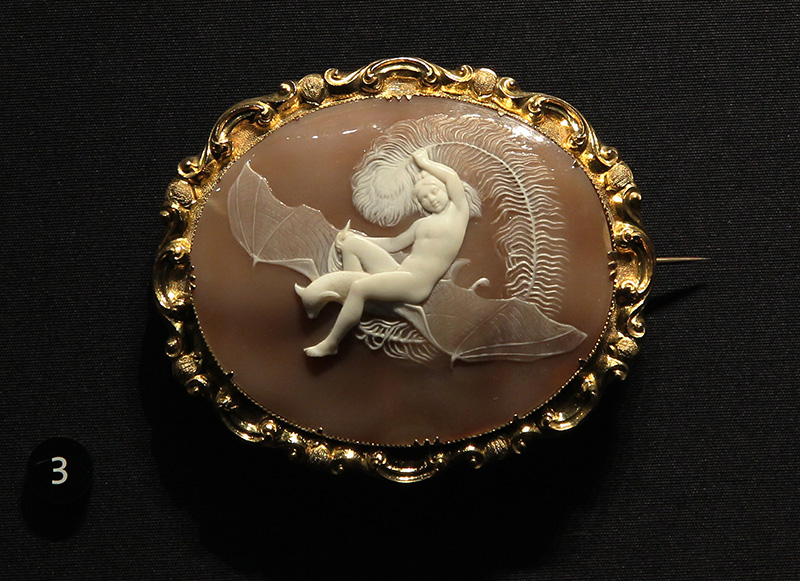
Source: Wikimedia / Vassil
Below, we’ll discuss the more modern periods of antique and vintage jewelry, but first let’s take a quick look at previous historical periods:
- Pre-Georgian jewelry is any piece that pre-dates the Georgian period (made before 1714). This includes a range of historical periods, including Ancient, Medieval, and Renaissance. While each has its characteristics, the use of gold, silver, bronze, and precious gemstones was common, as was a heavy emphasis on Christian elements such as crucifixes.
- Georgian Era pieces date from 1714 to 1837, during the reigns of George I, George II, George III, and George IV of England. The period is characterized by ornate pieces incorporating Rococo, Gothic Revival, and Neoclassical aesthetics.
- The Victorian Era coincided with the reign of England’s Queen Victoria, from 1837 to 1901. Victorian pieces feature classical motifs, gemstones from across the British Empire, lots of black to reflect Queen Victoria’s long mourning period, and the final part of the era saw the introduction of manufactured jewelry.
Edwardian
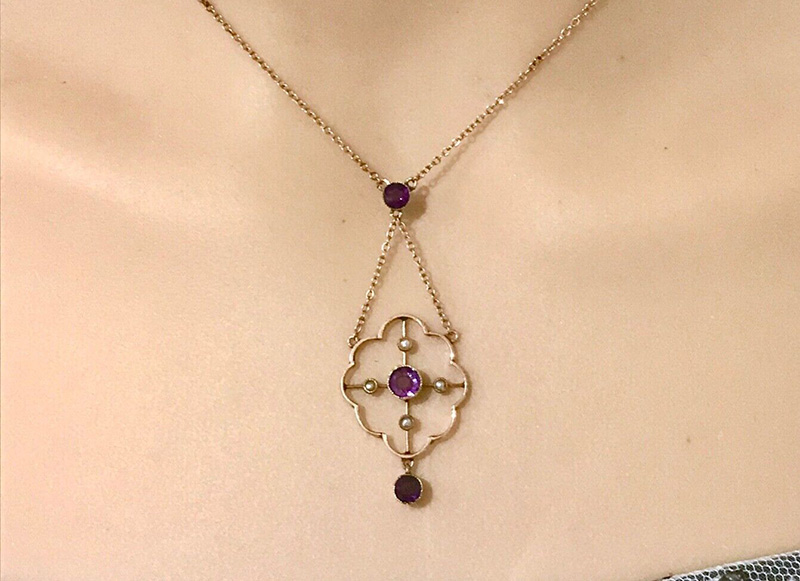
Source: eBay
The Edwardian period fell during the reign of the British King Edward VII, successor to Queen Victoria, who sat on the throne between 1901 and 1920.
This classification can be given to English fashion, furniture, and technology too.
The period involved radical progress across many of these areas, including fostering a distinct new style of jewelry, characterized by elegance, luxury, and the use of the finest of materials.
Platinum had only recently entered the jewelry industry during the period, as metalworkers developed the skills to refine and cast the metal which had been discovered in South America in the 16th century.
Edwardian jewelers and designers incorporated it enthusiastically, making use of the super-strong metal’s ability to be drawn into thin wire to create elegant, intricate designs with elements like mesh and delicate garlands. These are characteristic of the Edwardian style and motifs inspired by ancient Greece and Rome.
Diamonds, rubies, emeralds, and sapphires were also prominently featured in Edwardian jewelry, particularly the former, thanks to the explosion of the South African diamond industry at the time.
Art Nouveau

Source: Wikimedia / Sailko
Art Nouveau coincided with the Edwardian period, but while the latter has concentrated in England, the center of the Art Nouveau world was continental Europe, especially France. The Jugendstil style was Art Nouveau’s counterpart in German-speaking countries.
This family of movements influenced art, the decorative arts, design, and architecture, and spanned two centuries: from around 1890 to 1919.
The movement was partly a rejection of industrialization and its mass-produced products, favoring unique, free-flowing motifs inspired by nature, which is reflected in Art Nouveau jewelry.
This period was all about original designs, with elements such as endless, asymmetrical lines, floral subjects inspired by the Arts and Crafts movement, and others inspired by Japanese woodcuts. Many also featured natural motifs, such as leaves, flowers, birds, insects, and fish, as well as mythical creatures like nymphs.
Another characteristic of the period was the use of gemstones that weren’t previously seen in fine jewelry, such as opal, moonstone, amber, citrine, and peridot, as well as unusual materials including tortoise-shell, ivory, shell, horn, and carved glass.
Art Deco
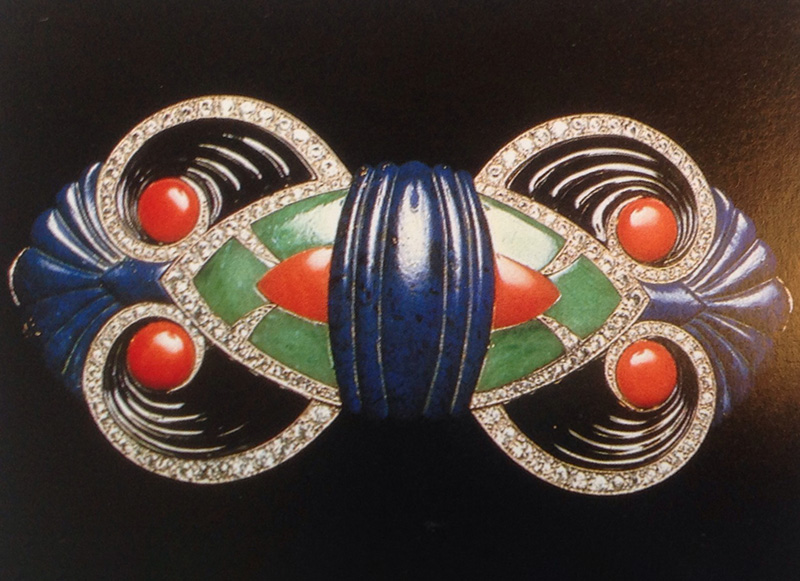
Source: Wikimedia / SiefkinDR
Another highly influential movement started in France, Art Deco kicked off at the Exposition Internationale des Arts Decoratifs held in Paris in 1925, which also gave the style its name and ran until the mid-1930s. This new art style, design, jewelry, and architecture were revolutionary at the time, with geometric shapes and bold colors.
These attributes were key to jewelry from the period, as well as contrasting tones, vast clusters of diamonds, and modern takes on classical motifs from ancient Egypt, Africa, and China. Fashionably bright tones were achieved through dazzling rubies, emeralds, and sapphires set in stark black enamel and platinum, and new materials like chrome, aluminum, and plastics, were featured in jewelry for the first time.
Art Deco is still seen by many as one of the pinnacles of jewelry design, not only for the aesthetics but also for the innovative use of new techniques and brand-new gemstone cuts. One iconic line from the time was Cartier’s “tutti frutti” pieces featuring gemstones carved into fruit shapes.
Other characteristic elements of the period were the sautoir, a long gold chain with a pendant, and the double clip, a piece that could be combined to form a large brooch or worn separately as dress clips.
Retro
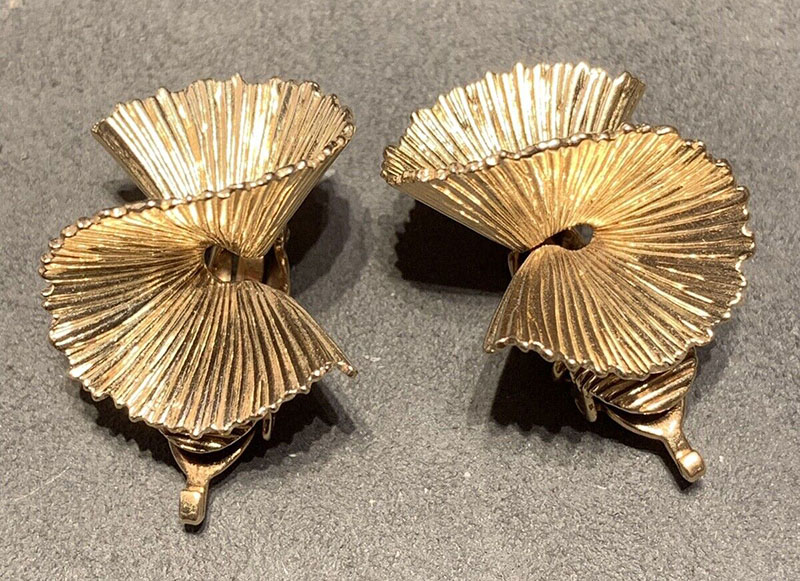
Source: eBay
The retro jewelry period followed Art Deco, from around the mid-1930s to about 1950, and kept some elements from the previous era, including the dramatic geometric shapes. The critical difference is that retro jewelry is dominated by metalwork and glossy metallic finishes, with fewer precious stones.
When gemstones were featured, they were either very small (reflecting the economic problems of the era) or oversized, synthetic stones. Platinum was also largely unavailable because it was dedicated to the war effort, so jewelry relied more on gold once again, and pink gold became particularly popular.
Machinery often influenced retro motifs: you may see elements from engines, padlocks, bicycle chains, cylinders, and even bullets.
This is separate from the term retro, which can be widely used to refer to designs and aesthetics from previous decades, as little as 20 years or so in the past.
Mid-century
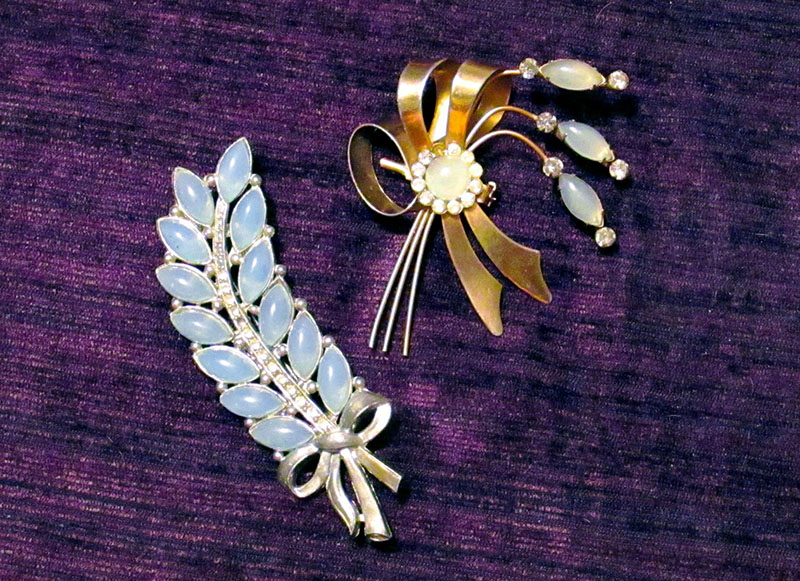
Source: Flickr / PINKE
As the name suggests, mid-century jewelry comes from the 1950s and early 1960s. This period is characterized by feminine designs and fantastical natural motifs featuring flowers, leaves, and animals.
Creative use of metal was prevalent, with jewelers manipulating this kind of material to create textures like mesh, braids, and brushed metal. Fine metals and jewels were introduced after periods of austerity and wartime, with diamonds and platinum becoming more popular.
Making jewelry sets was also very popular – you’ll often see identical necklaces, bracelets, brooches, and earrings.
Modern
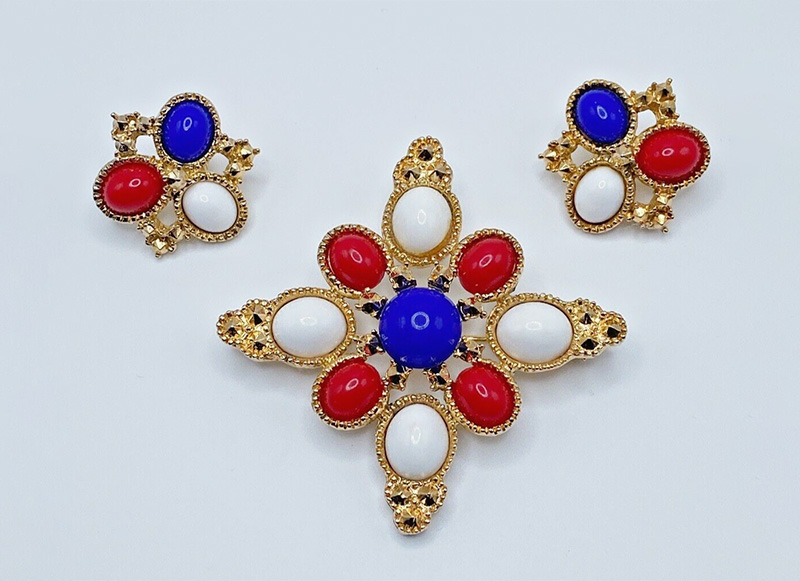
Source: eBay
The “modern” period is considered to start in the mid-1960s. This was a time of incredible social change, and its jewelry reflects this with abstract designs and organic motifs.
Texture was a big part of the aesthetic of the time, achieved with techniques such as embossed metal and fields of tiny diamonds. Yellow gold and colorful gemstones were trendy throughout the 1960s and 1970s, as well as Bohemian and multicultural influences, in step with fashion from the same era.
In the 1980s, jewelry took on the power dynamic of the decade with large, chunky pieces and square shapes.
Why you should consider buying estate jewelry
Second-hand items sometimes come with a degree of stigma, and this may deter you from buying estate jewelry.
However, these types of pieces have a range of benefits, including:
- Estate jewelry is generally more sustainable and ethical than buying new, as you don’t need to worry about the negative impacts on people and the environment of obtaining the materials or manufacturing the final piece.
- You’ll find a range of unique pieces that you can use to express your personality and create your own fabulous sense of style.
- You can find fine estate pieces made from precious materials at much more affordable price points than comparable new items.
- Many estate pieces are fine examples of expert craftsmanship, thanks to the superior standards of the jewelry industry in bygone eras.
How to shop for estate jewelry
There is a wide range of estate jewelry available, including some truly remarkable pieces for various price points. However, shopping for estate jewelry and making wise purchasing decisions can be tricky, especially if you have limited experience or knowledge on the subject.
What’s the best place to buy estate jewelry?
When buying estate jewelry, you have two main options: purchase from a dealer or store, or buy from an individual.
Generally speaking, using a reputed dealer specializing in estate jewelry is the best way to ensure you buy a quality piece for a reasonable price. However, this is not always the case: you may still get ripped off by dishonest dealers, so it’s essential to be cautious, no matter where you shop.
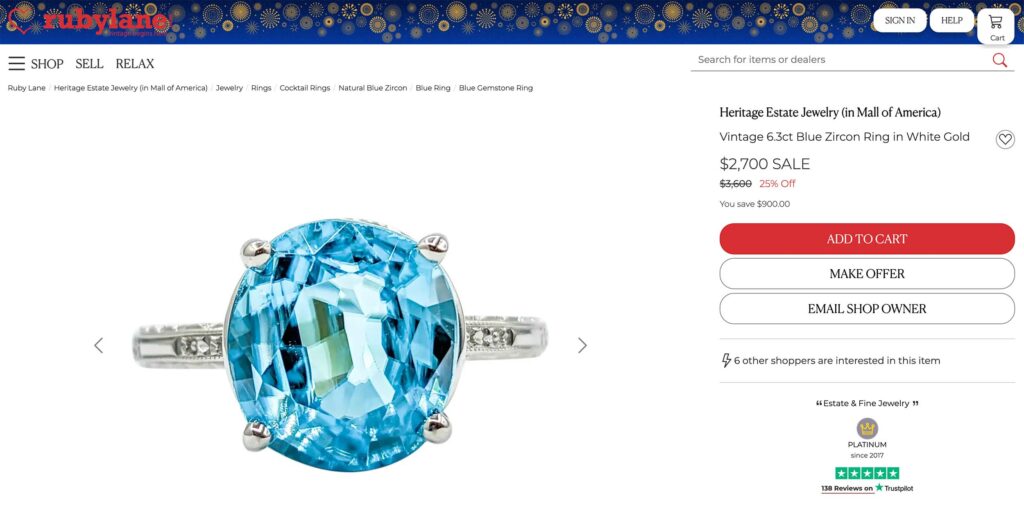
Equally, you can find some fantastic deals from private sellers if you know what you’re looking for (more on identifying estate jewelry and tips for savvy shopping later).
An excellent place to start is by looking up local antique dealers and vintage stores, as well as jewelers specializing in estate pieces, in your area. You can also trawl through charity shops and garage sales, but be prepared to put in plenty of hours with no guarantee of a lucky find.
There are also plenty of opportunities to buy estate jewelry online, including:
- Rubylane
- Adored Vintage
- Era Gem
- Doyle & Doyle
- Archive Vintage
- Lang Antiques
- What Goes Around Comes Around
- Estate Diamond Jewelry
- Wilson’s Estate Jewelry
- Etsy stores such as Maejean Vintage and Chenier Studio Co
- Online marketplaces like Ebay and Craigslist
How to identify estate jewelry
Some unscrupulous dealers may use the term “estate” to make it seem like a piece is older than it is; labeling reproduction pieces as such gives the impression they are, in fact, antiques. While calling any second-hand jewelry item estate is technically correct, it’s essential to know the differences in historical periods and materials to be able to evaluate estate pieces.
The safest route is to have any piece of estate jewelry authenticated so that you know it is genuine.
It’s always a good idea to have an independent expert assess and authenticate a piece before you finalize the purchase, especially more expensive items. Reliable estate jewelry dealers will usually supply authentication documentation for valuable pieces, so be sure to ask for this.
If you want to do a quick check yourself, here are some ways to identify antique and vintage jewelry:
- Look for markings on gold jewelry that indicate the metal’s level of purity: this may either be the number of karats, shown as 14k, 18k, and so on, or a three-digit number.
- Check for jeweler’s markings: all modern pieces and many high-quality older pieces will bear a mark identifying the manufacturer, which you can use to work out who made it and when
- Examine the quality of the stones: gemstones should be bright and lively in more valuable pieces, and if there are multiple diamonds, pearls, or gemstones of the same type, the colors should match well.
- If the item has a patina or signs of wear and age, it’s a good indication that it is vintage or antique.
- Compare design motifs and techniques to those that were popular in each historical era: this is an indication of when it may have been made, though it could also be a later imitation.
How estate jewelry is appraised
When experts authenticate estate jewelry, they often also appraise it. In essence, this is a process that looks at a range of factors to determine the subjective value of the piece.
As part of the appraisal, experts will consider:
- Metal purity and jeweler’s markings
- The age of the item
- The known history of the item, including the jeweler who made it
- The type and quality of the materials
- Its retail value and replacement price
Like authentication, it can be a good idea to have any expensive or potentially valuable piece independently appraised before you make your final purchasing decision.
What to be aware of when buying estate jewelry
Buying any kind of second-hand item always comes with some degree of risk, as it can be harder to be sure about how it was made. This risk is heightened when you buy high-value items such as jewelry.
Given all of this, it’s important to educate yourself and have a certain degree of caution before purchasing estate jewelry.
Here are some tips on how to be a savvy consumer when shopping for estate jewelry:
- Check for markings on the piece that may indicate who made it and/or the purity of the metals.
- For more valuable items, have an independent expert authenticate or appraise the piece, or ask the dealer for an official authentication.
- Ask about the return policy: it’s best to only buy from dealers or sellers that accept unconditional
- returns.
- If buying online, make sure that you have comprehensive information about the piece, including a detailed description, specs, and multiple photos from various angles to show any defects.
- Avoid any items that are not in good condition, such as anything that is broken or missing any parts.
Key terms and definitions
Beyond the definitions of estate, antiques, and vintage jewelry, knowing certain terms will also help you to make wise purchasing decisions:
- Abrasion: A scratch or bruise on the surface of a gemstone.
- Carat: A unit of weight for diamonds and other gemstones. One carat represents 200 milligrams (0.007 ounces)
- Custom: Any piece made for a specific customer according to their specifications.
- Designer: Designer jewelry was designed and manufactured by a certain designer, though the value can range widely depending on the specific designer.
- Inclusions: Usually used to refer to diamonds, an inclusion is any kind of internal flaw or imperfection in a gemstone.
- Karat: Not to be confused with carat, which is the weight of a gemstone, karat describes the level of purity of gold out 24. While 24 karat gold is almost (99.9%) pure, 18 karat gold, for example, is an alloy of 18 parts gold and six parts other metals like copper and silver.
- Lab diamond or gemstone: Any stone that has been manufactured through a controlled process in the lab, rather than found in nature.
- Period: A piece of jewelry from a recognized time period, whether Edwardian or Modern.
- Reproduction: Pieces made in the style of an earlier era. For example, an Art Deco reproduction piece may have been made later, such as in the 1980s or 1990s.
- Revival: Unlike reproduction, which is a straight imitation, revival pieces incorporate design elements and motifs from older eras but with a new flair. These pieces may be antiques in and of themselves, such as Renaissance and Egyptian revivals made in the late 19th century.
When buying diamonds, there is some specific terminology you should be aware of. Most notably, the value and quality of any diamond is determined by the four Cs or “4Cs”.
The 4Cs are:
- Cut: How well the diamond is cut to maximize its beauty and brilliance.
- Color: The diamond’s tint is graded from colorless (D) to saturated (Z).
- Clarity: How many (or few) blemishes or inclusions it has.
- Carat weight: The weight, and therefore size, of the diamond.
Final thoughts
Estate jewelry is a broad term that could mean anything from a dazzling 150-year-old sapphire and diamond necklace to a simple bracelet manufactured a few years ago from base metals.
However, within this range are some fantastic pieces that offer incredible value for money for the craftsmanship and materials used. You’ll also find plenty of stunning estate items that allow you to express your personality and develop your own unique sense of style.
Now you have a clear idea of what is estate jewelry and what to look for when shopping for vintage and antique pieces, it’s time to get shopping and find your own gems!
If you’re interested in learning more about the world of jewelry, check out our guide to fashion jewelry vs fine jewelry.

